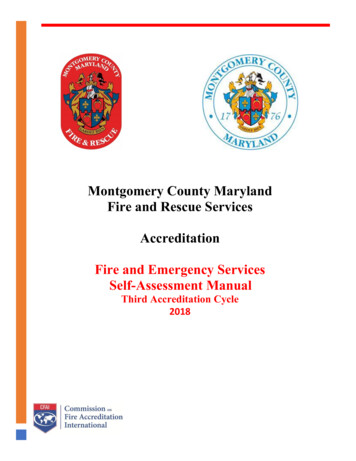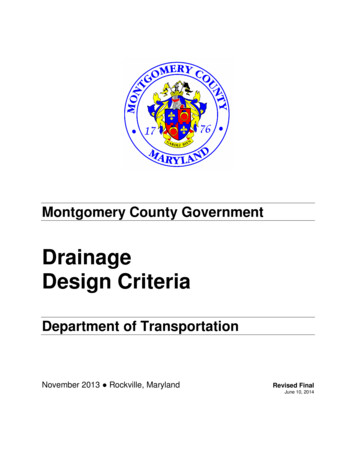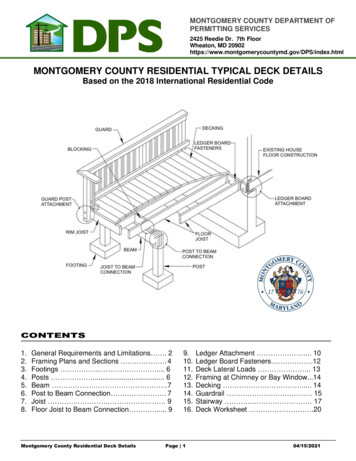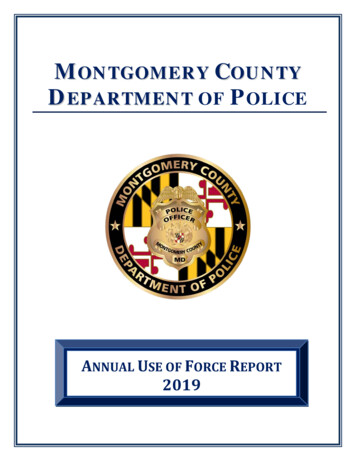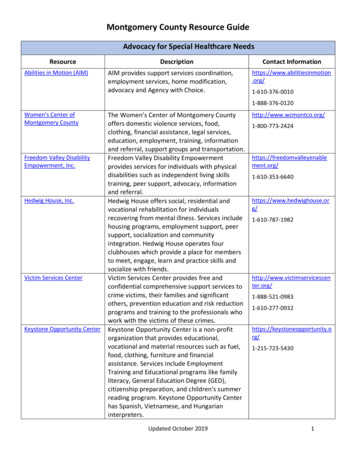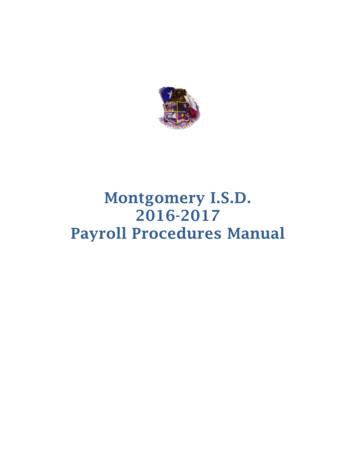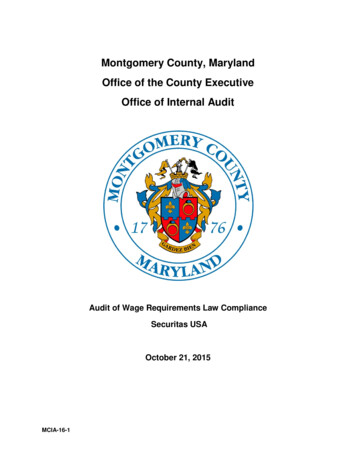
Transcription
Montgomery County, MarylandOffice of the County ExecutiveOffice of Internal AuditAudit of Wage Requirements Law ComplianceSecuritas USAOctober 21, 2015MCIA-16-1
HighlightsOctober 2015Why MCIA Did this AuditAudit of Wage Requirements LawCompliance – Securitas USAContractors who provide services to theCounty are subject to the MontgomeryCounty Code provisions regardingcompliancewithcertainwagerequirements payable to the contractor’semployees under the County’s WageRequirements Law (Wage Law). TheMontgomeryCountyOfficeofProcurement’s (Procurement) 1 Division ofBusiness Relations and Compliance(DBRC) is responsible for monitoringcompliance with the Wage Law. TheCounty’s Sheriff’s Office has a contractwith Securitas USA, Inc. (Securitas), toprovide security guard services.In February 2015, Procurement requestedthat the Office of Internal Audit (MCIA)perform a Wage Law audit of Securitascovering all of its employees who performwork in Montgomery County, to includethe months of June 2014, July 2014,December 2014, and January 2015. Theaudit was conducted by the accountingfirm SC&H, under a contract with MCIA.What MCIA RecommendsMCIA is making three recommendationsto Procurement dealing with thedetermination of the relief to seek againstSecuritas for statutory or contractviolations arising from noncompliancewith the Wage Law.1Prior to March 26, 2015, DBRC was part of theCounty’s Department of General Services.Effective March 26, 2015, DBRC was reorganizedto be part of a newly created Office of Procurement,which is a principal Office of the County’s ExecutiveBranch.MCIA-16-1What MCIA FoundSecuritas did not comply with the Wage Law in allinstances. Based on the information that was providedto us by Securitas, and the testing criteria provided to usby the Office of Procurement (Procurement), Securitasunderpaid its employees in 6 of 362 instances that wewere able to test 2. This resulted in a total underpaymentof 34.47. In addition, our testing was limited by isolatedinstances in which we were not able to obtain allnecessary documentation to complete our testing.Specifically, our testing identified 3 instances (of the 365available instances) in which there was no evidence ofemployee wages included on the payroll registers thatSecuritas provided for our testing; however, theemployees’ hours worked were included in thecontractor’s time reporting software system (SAFES)reports or manual timesheets that the County providedafter receiving from Securitas for the corresponding timeperiods. Securitas’ inability to provide payroll recordsfor these three isolated instances is, itself, a violation ofCounty Wage Law requirements. In addition, Securitasdid not provide documentation to support its reductionof the hourly wage paid under the Wage Law to coverthe employee hourly cost of the employer’s share of thehealth insurance premium.2The six instances in which employees were underpaid occurred during theweeks associated with the July 17, 2014 and July 31, 2014 pay dates. Anincrease to the County-required wage rate from 13.95 per hour to 14.15per hour took effect on July 1, 2014.
TABLE OF CONTENTSObjectives . 4Background. 4Scope and Methodology . 7Findings . 10Recommendations to the Director of Procurement . 11Comments and MCIA Evaluation . 12Appendix A – Total Underpayment Amount per Employee . 13Appendix B – Excerpts from Wage Requirements Law and Contracts . 14Appendix C – Available Remedies for the County . 18Appendix D – Office of Procurement and Securitas Responses . 19MCIA-16-1
ObjectivesThis report summarizes an audit performed by SC&H Group under contract with the MontgomeryCounty (County) Office of Internal Audit (MCIA) to review and determine compliance with theWage Requirements Law (Wage Law), under Montgomery County Code § 11B-33A. The primaryobjective of the audit was to review and determine compliance with the Wage Law by SecuritasUSA, Inc. (Securitas), a County contractor.This internal audit was performed in accordance with consulting standards established by theAmerican Institute of Certified Public Accountants (AICPA) and generally accepted governmentauditing standards (GAGAS) established by the Government Accountability Office, asappropriate. SC&H Group’s proposed procedures were developed to meet the objectives statedabove, and were reviewed and approved in advance by MCIA. The interviews, documentationreview, and field work were conducted from June 2015 to August 2015.BackgroundWage Requirements LawThe County Council passed, on June 11, 2002, and the County Executive signed on June 20,2002, Bill 5-02 3, relating to Wage Requirements pertaining to service contracts. Under this law, acontractor who provides services to the County is subject to the Montgomery County Coderegarding compliance with certain wage requirements payable to the contractor’s employees. Ifthe resultant contract will be subject to the Wage Law, there also are mandatory submissionrequirements applicable to the corresponding solicitation. The Chief Administrative Officer adjuststhe wage rate annually, effective July 1st of each year. The following table details the respectiveWage Law amount effective for the time period under review.Table 2 –Wage Law RateWage Law RateJuly 1, 2013 –July 1, 2014 –June 30, 2014June 30, 2015 13.95 14.15Contractor Certification of Wage Law ComplianceThe County Office of Procurement’s (Procurement) Division of Business Relations andCompliance (DBRC) is responsible for monitoring compliance with the Wage Law. In accordancewith County Procurement requirements, a bidder on a contract that is subject to the Wage Lawmust submit a signed Wage Requirement Certification Form with its bid or proposal submission.On the form, the contractor must indicate its intent to comply with the Wage Law or indicate whichexemptions or reductions from the Wage Law apply. In addition, not-for-profit organizations thatare exempt from the Wage Law can decide to opt-in to comply with the law.Securitas did not qualify for general exemption status because, at the time of contract execution,it was estimated that the payments received under the contract would exceed 50,000. Paymentsmade to Securitas in 2013, 2014, and 2015 were approximately 682 thousand, 1.7 million, and 1.2 million, respectively. Also, since Securitas is not recognized as a not-for-profit ontent/council/pdf/bill/2002/05-02e.pdf4MCIA-16-1
neither the nonprofit organization exemption, nor the accompanying opt-in election to comply withthe Wage Law, are applicable.Securitas’ application to reduce the required wage amount below Wage Law requirements bydeducting the employer’s share of the employees’ health insurance premium it was paying wasaccepted by the County. The following table details the exemptions or reductions, and optionalcompliance, for which a contractor may be eligible under the Wage Law.Table 3 – Allowable Wage Law Exemptions, Reductions, and Optional tusExemptionNon-profitWage andHealthInformationWageRequirementsReductionA contractor, who, at the time acontract is signed, has receivedless than 50,000 from theCounty in the most recent 12month period and will be entitledto receive less than 50,000 fromthe County under that contract inthe next 12-month period. Montg.Co. Code, §11B-33A (b) (1) (A) &(B).A contractor that is a non-profitorganization is exempt fromcoverage. Montg. Co. Code, §11B-33A (b) (3).A contractor that is a “coveredemployer,” may reduce its hourlyrate paid under the Wage Law byan amount equal to, or less than,the per employee hourly cost ofthe employer’s share of thehealth insurance premium.Montg. Co. Code, § 11B-33A (d)(1) & (2); see also 11B-33A (c).ReductionOpt-InNon-profit’sComparisonPriceA contractor that is a non-profitmay opt to pay its coveredemployees the hourly ratespecified in the Wage Law andnot be penalized in a solicitationdue to the additional amount inits price that results from payingthe Wage Law amount. SeeMontg. Co. Code, § 11B-33A (b)(3) & (c) (2).5MCIA-16-1Applies toSecuritasNoNoYesNo
Qualifications for Allowable Reduction to the Required Wage Law AmountIn order to qualify for the allowable health insurance reduction to bring the required wage to anamount below the Wage Law, a contractor must indicate at the time of, and in, its bid or proposal(on the Wage Requirement Certification Form), its intent to take the health insurance reduction(including how it and its subcontractors will comply with the wage requirements, and that it hassufficient funds to meet the wage requirements 4). In addition, Per the Wage Law, If a contractoror subcontractor commits in its bid or proposal to provide health insurance to any employee whoprovides services to the County, the contractor or subcontractor may certify in its bid or proposalthe per-employee hourly cost of the employer's share of the premium for that insurance, andreduce the wage paid under subsection (e) to any employee covered by the insurance by all orpart of the per-employee hourly cost of the employer's share of the premium.As a part of Securitas’ proposal, Securitas applied for a wage rate reduction up to 1.50/hr basedon the portion of the health insurance premiums that it paid on behalf of its employees. TheCounty accepted Securitas’ application to reduce the required hourly wage rate by up to 1.50/hr,and incorporated by reference this allowable reduction in the County’s contract with Securitas.Beginning January 1, 2015, Securitas reduced the wages of employees who performed work forthe County by 0.72/hr, to cover the cost of the health insurance premiums paid by Securitas tothe benefit of its employees. [NOTE: No previous reduction for the cost of health insurancepremiums had been applied.]Wage Law Compliance – ContractorEach contractor that is subject to the Wage Law must perform tasks to show compliance with theWage Law. First, the contractor must certify that it, and each of its subcontractors with whom itworks, is aware of, and will comply with, the applicable wage requirements. Second, thecontractor must keep and submit any records necessary to show compliance with the law. Third,the contractor must conspicuously post notices informing employees of the wage requirements.Further, the contractor must submit quarterly certified payroll reports to the Office ofProcurement’s (Procurement) Division of Business Relations and Compliance (DBRC). 5Contractor Selected for AuditProcurement requested the MCIA to perform a Wage Law audit of Securitas covering all of itsemployees who perform work in Montgomery County, for the months of June 2014, July 2014,December 2014, and January 2015. In response, MCIA directed its audit contractor, SC&H, toaudit Securitas’ compliance with the Wage Law.45Montg. Co. Code, § 11B-33A (c)(1).Montg. Co. Code, § 11B-33A (h)(1) (A) - (C).6MCIA-16-1
Scope and MethodologyWage Compliance Scope and MethodologyAt the request of the County, we reviewed Securitas’ compliance with the Wage Law for themonths of June 2014, July 2014, December 2014, and January 2015. We requested thatSecuritas provide us with timekeeping and payroll documentation to support 100% of the payrollperiods for each of the months selected for testing.Payroll PopulationTo evaluate Securitas’ practices, and its compliance with the Wage Law requirements, we firstconducted interviews with members of Securitas management to gain an understanding of timekeeping practices, payroll procedures, and fees deducted from employee pay. We also requesteddocumentation for each of the pay periods that occurred during the months of June 2014, July2014, December 2014, and January 2015. For each payroll period, we requested the PayrollRegister showing all employees that performed work under the Montgomery County contractsduring that pay period, as well as evidence of the hours that each included-employee workedduring the period, and each employer deduction from the employee wages.Our population size included a total of nine pay periods within the in-scope time period of June2014, July 2014, December 2014, and January 2015. Securitas provided us with payroll registersfor each pay period. To corroborate that the population of employees included on each payrollreport represented the complete population of employees that performed work under MontgomeryCounty contracts during that period, we requested that Securitas provide us with a listing of allemployees, past and present, who performed work on the County’s contract. In addition to theemployee list provided by Securitas, we also obtained the source timesheets completed by allSecuritas employees each week, as well as the time reporting software system reports that areagreed upon by both the employee and their Securitas supervisor, and help reconcile theemployee’s pay each period.Table 4 – Documents and Information RequestedDocumentation and/orInformation RequestedDocument and/orInformationReceivedCommentsTimekeeping records forpayroll periods selected fortestingReceivedSecuritas employees record time through theuse of timesheets. Securitas uses the hoursfrom the timecards to populate a time reportingsoftware system (SAFES).Wages paid to employees forpayroll periods selected fortestingReceived, withLimitedExceptionsWith the exception of three isolated instances,Securitas provided employee wage supportdocumentation for each of the nine payrollperiods selected for testing (362 of 365 recordsreceived).7MCIA-16-1
Documentation and/orInformation RequestedDocument and/orInformationReceivedCommentsDetail of deductions takenfrom employee gross pay bytype of deductions andamounts for each employeefor payroll periods selectedfor testingReceived, withLimitedExceptionsWith the exception of three isolated instances,Securitas provided the detail of deductionstaken from employee gross pay by type ofdeductions and amounts for each employee foreach of the nine payroll periods selected fortesting (362 of 365 records received).Based on the payroll information provided by Securitas, we had payroll data for a total number of362 testable instances (total employee instances from the payroll records/periods provided forwhich both payroll and timekeeping records were made available).Employee WagesSecuritas pays its employees an hourly rate that could vary based on employee level, experience,etc. To be compliant with the County’s Wage Law, this rate should be at or above the County’srequired wage amount in each instance.Note: As previously stated, the County accepted Securitas’ request to reduce the required hourlywage rate by up to 1.50/hr. Beginning January 1, 2015, Securitas reduced the hourly wagespaid to its employees by 0.72/hr, to cover the cost of the health insurance premiums paid bySecuritas to the benefit of its employees. For the selected pay periods occurring throughoutJanuary 2015, we reduced the applicable wage rate by 0.72/hr to cover the cost of the healthinsurance premiums paid by Securitas. As such, the wage rate used in the January 2015 wagerate compliance calculations was as follows: 14.15 (applicable wage rate) – 0.72 (wage rate reduction) 13.43/hrEmployee TimekeepingEmployees record the time at which they begin work each day, as well as the time at which theyconclude work each day by using a timesheet on which they handwrite the start time each morningand ending time each night. At the end of each week, the employees each sign off on thetimesheets to verify the accuracy of the hours that they entered, and the Securitas supervisor alsosigns off on the bottom of the timesheet as evidence that he/she agrees with, and the contractorand its workers have reconciled any discrepancies regarding, the hours included on the timesheetfor each employee.Following each week, Securitas loads these handwritten timesheets into the time reportingsoftware system (SAFES). Once the information has been loaded into the system, the employeeand the Securitas supervisor each review, reconcile, and sign off on the hours for the period.For the purposes of our testing, we utilized the SAFES reports as the basis for the hours that weused in our calculations. The SAFES hours for each period were selected because theyrepresented the uploaded employee submitted hours. However, when the SAFES report hourswere not provided, we used the employee handwritten timesheet hours in our calculations as theemployee entered, approved, and submitted these hours each week.Hourly Wage Calculation8MCIA-16-1
In each instance that we tested, our methodology for computing employee hourly rates by whichto determine Securitas’ compliance with the County’s Wage Law was based on guidance that wasprovided by the County. Based on that guidance, our Wage Law compliance testing was toperform a calculation in each instance that uses the employee’s “Regular Earnings,” 6 and dividingby the employee’s “Regular Hours” 7 reported for that period to determine the Hourly Wage Ratefor each employee for that period. The Regular Hours were taken from the SAFES time reportingsystem reports (and, where applicable, the handwritten timesheets).TestingIn order to determine whether Securitas paid its employees in accordance with the County’s wagerequirement, we compared the Hourly Wage Rate that was calculated in each instance of ourtesting, to the Wage Law Rate that was in effect at the time of the pay period tested. For the payperiods that occurred during January 2015, we reduced the required wage rate by 0.72 to reflectthe wage rate reduction for Securitas’ payment of employee health care premiums, for which theyreceived a waiver from the County. As noted above, beginning January 1, 2015, Securitasreduced the hourly wages paid to its employees by 0.72/hr, to cover the cost of the healthinsurance premiums paid by Securitas to the benefit of its employees.Each instance where the Hourly Wage Rate that an employee was paid by Securitas was lessthan the County’s required Wage Law Rate was considered an exception.In order to calculate the amount of underpayment for each exception, we multiplied the WageLaw Rate that was in effect at the time of the pay period tested by the Regular Hours that werereported for that instance to determine the Calculated Regular Earnings (rounded to the nearestcent). We then subtracted the amount of Reported Regular Earnings that were paid to theemployee in that pay period. The resulting amount represented the underpayment for thatemployee, for that pay period. The sum of each of these instances provided us with the totalamount of underpayment that we could determine based on the information that was provided bySecuritas for our testing.Example (1 Employee):Wage RateRegular HoursCalculated Regular EarningsX 13.9536.05502.90Reported Regular EarningsOver/(Under)– 500.00 (2.90)6“Regular Earnings” is defined as wages paid for hours worked, up to 40 hours per week. RegularEarnings do not include wages earned for Overtime, Vacation Time, Holiday Time, Sick Time, Paid TimeOff, etc.7“Regular Hours” are hours actually worked by an employee, up to 40 hours per week. Regular Hours donot include hours logged for Overtime, Vacation Time, Holiday Time, Sic
Oct 21, 2015 · Beginning January 1, 2015, Securitas reduced the wages of employees who performed work for the County by 0.72/hr, to cover the cost of the health insurance premiums paid by Securitas to the benefit of its employees. [NOTE: No previous reduction for the cost of
